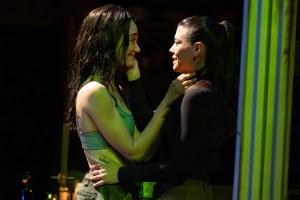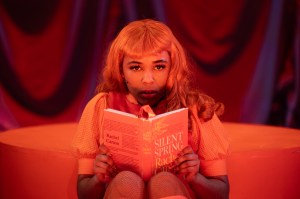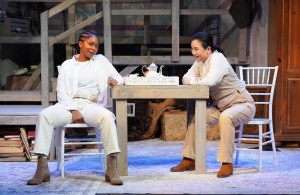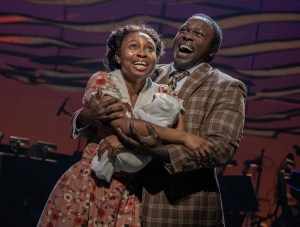
in The Real Thing
Playwright Tom Stoppard has been getting a bum rap over the years. The conventional wisdom is that Stoppard enchants his audiences by stringing words in front of them like a hypnotist who slowly swings a watch on a chain, and that he isn’t the man one thinks of when it comes to probing human feelings on the stage. According to many of his critics, it has only been with his more recent plays–such as Arcadia and The Invention of Love–that Stoppard has revealed a beating heart to match his churning mind.
David Leveaux’s revival of The Real Thing, Stoppard’s 1982 comedy-drama, refutes this idea. It proves not only that the playwright did infuse his earlier works with pulsing emotion, but that he was aware of the particular effort it took for him to do so. In other words, The Real Thing was (and remains) an admission about an omission of a certain kind. Stoppard himself has said that the piece–with a playwright named Henry as its focal figure–does reflect some of his own attitudes, although he maintains that the play is not autobiographical. Fair enough; if making distinctions between attitudes and actions makes the playwright more comfortable, then so be it.
Stoppard wrote The Real Thing with so much skill that the play still leaves an audience alternately breathless or holding its breath. The work is relentlessly clever in order to illustrate how, in regard to affairs of the heart, cleverness can be a handy cover-up for long denied instincts. “What’s so good about putting words together?” Henry is asked, and Stoppard makes a play that shows in equal measure what’s great about word manipulation and what’s dire about it.
So ingenious is Stoppard in his examination of the search for the “real thing” in love that he begins his play with a scene that is not what it seems to be. This tart, rancorous interlude–in which a man learns he’s being betrayed, and a woman owns up to the betrayal–is actually a sequence from playwright Henry’s latest piece, House of Cards. But there is an element in this WASPish opus that does reflect a reality of Henry’s life: Henry himself has fallen out of love with his wife, Charlotte (the House of Cards actress) and fallen in love with Annie (the actress-wife of the House of Cards actor, Max).
What follows in The Real Thing is a series of brittle, melting scenes that cover the next two and a half years of the characters’ lives, providing a look at Henry’s and Annie’s marriage, Annie’s dalliance with a young actor named Billy, and Henry’s relationship with his daughter, Debbie. Throughout, Stoppard examines the difficulties inherent in sustaining passion and commitment, and the role that communication–with or without words–plays in the process. The opening play-within-a-play features a man who is erecting a literal house of cards, and with it, the Henry character demonstrates that he’s already brooding over the ephemeral quality of romantic alliances. Ironically, Henry’s playwriting abilities give him no hedge against love’s unfavorable odds; with his face rubbed in Annie’s infidelity, he is as bamboozled as the next, less intelligent fellow might be.
Stoppard has always been deft at creating male characters who can’t command themselves despite their command of the language. (Remember that, for Stoppard, English is a second language–just as it was for Vladimir Nabokov.) In Henry, who loves bad rock groups but can’t get a purchase on classical music, Stoppard has constructed a figure of towering uncertainty. Charlotte accuses Henry of possessing not a sense of humor but a “joke reflex,” and she’s right. As Henry attempts to deflect flack from his successive wives–the first being philandered on, the second philandering–he is rarely lost for wry words. (When Annie asks him, “Will you stop…,” he helpfully replies, “…finishing your sentences?”)










